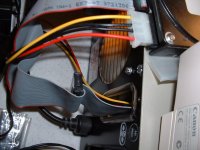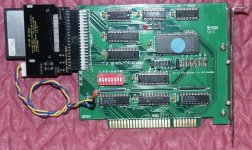Holmes
Experienced Member
So I am about to get my XT-IDE kits and will soon begin soldering away. I've been searching for any threads where people list their XT-IDE setups. I've seen on the wiki that working hard drives and CF cards are listed, but there's a big gap between this info and what you need to organize your setup. All other info is pretty scattered.
For instance, does anyone have a setup with 2 IDE devices attached (either an HD + CF card reader)? Does anyone have a IDE-to-dual-CF setup and working? Can you put a CF-to-IDE reader with a slot-bracket in the same slot position as the XT-IDE card (is there room physically)? Does anyone have a laptop HD working? If so, with what type of adapter? How have people solved the power problem (supplying your HD or CF with power)?
Those are the types of questions I think would be helpful for those new to this like me. Most of the other threads out there require you to dig through 20 pages of discussion about some very isolated and specific situations, which are obviously very important to those with the issue, but less important to those without that exact setup.
So what I would like is a thread devoted to different XT-IDE setups. Like I said, I think this would be a ton of help to those taking the plunge. Maybe it would give some ideas to those who already have one but didn't think of a certain arrangement.
What to include
---------------
Please include your computer, all hardware components (be as specific as possible), and pictures would be great (ideas about mounting of HDs, etc), in addition to any difficulties you had with your setup. Please don't use this thread as a problem solving/troubleshooting thread. I would also ask that if you need to add to or modify what you wrote, please edit your original post rather than adding a new reply with a comment about a previous posting (to keep the thread from becoming digital kudzu). This will hopefully keep the information more accessible to all. Feel free to ask clarification questions, though.
Anyone else agree? If so, then please post away! I'm excited to see what you guys have done with your XT-IDEs.
For instance, does anyone have a setup with 2 IDE devices attached (either an HD + CF card reader)? Does anyone have a IDE-to-dual-CF setup and working? Can you put a CF-to-IDE reader with a slot-bracket in the same slot position as the XT-IDE card (is there room physically)? Does anyone have a laptop HD working? If so, with what type of adapter? How have people solved the power problem (supplying your HD or CF with power)?
Those are the types of questions I think would be helpful for those new to this like me. Most of the other threads out there require you to dig through 20 pages of discussion about some very isolated and specific situations, which are obviously very important to those with the issue, but less important to those without that exact setup.
So what I would like is a thread devoted to different XT-IDE setups. Like I said, I think this would be a ton of help to those taking the plunge. Maybe it would give some ideas to those who already have one but didn't think of a certain arrangement.
What to include
---------------
Please include your computer, all hardware components (be as specific as possible), and pictures would be great (ideas about mounting of HDs, etc), in addition to any difficulties you had with your setup. Please don't use this thread as a problem solving/troubleshooting thread. I would also ask that if you need to add to or modify what you wrote, please edit your original post rather than adding a new reply with a comment about a previous posting (to keep the thread from becoming digital kudzu). This will hopefully keep the information more accessible to all. Feel free to ask clarification questions, though.
Anyone else agree? If so, then please post away! I'm excited to see what you guys have done with your XT-IDEs.
Last edited:



